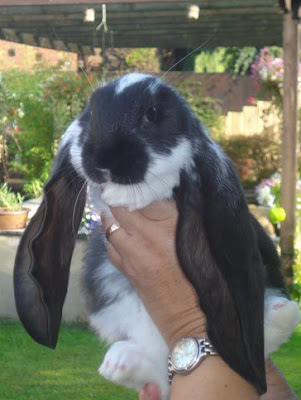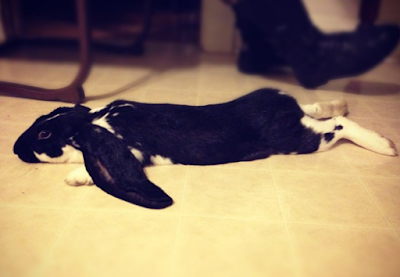English Lop Rabbit: First Of All Lop Ear Rabbits With The Longest Ears
Aren't you reminded of a familiar childhood character whenever you see a Lop Ear Rabbit? We'd often reminisce about Dumbo the elephant and his struggles with his unusually large ears— Just one of the many reasons we share as much love for large droopy ears on a bunny. As opposed to actually being sad, lop ear Rabbits are known to be a rather playful bunch.
Just how and which breed did these adorable ears come from?
The English Lop
The English Lop
Rabbit is the first breed of lop eared rabbits in the world, and also one of
the oldest domestic breed of rabbits. They were first developed in England
during the 19th century through selective breeding, for the purpose
of increasing popularity of rabbits as household pets, rather than for wool, fur
and meat production.
 |
| Source |
The following of
French Lops was developed by breeding a Flemish Giant (both amongst giant Rabbit breeds) and English Lop, and the dwarf sized Lop ear breed Holland Lop was
bred from a French Lop and a Netherland Dwarf. As breeders began to take notice of the English
Lop Rabbit, so did the demands for small fancy Pets increase— all of which happened during the Victorian
Era.
Fun Fact #1 The long, huge
ears of the English Lop Rabbits were said to help them better adapt them in the harsh
climates of Algeria, North Africa. The large ears lose body heat and kept these Lop
eared bunnies breezy and cool.
Appearance Of An English Lop
Size — An English Lop is a
relatively large rabbit. Adult Females weigh 4 to 6 kgs, and
adult Males 4 to 5 kgs. They have a medium build body the shape of a mandolin.
Features — The most distinctive feature of them all: Long, forward-facing, silky furred ears. These ears should be broad in the middle, and rounded at the ends. Most English Lop Rabbits have ears that measure 60 to 70 cm from tip to tip when panned out.
Form — Rounded hinds and sloped back carry a broad head that sits low.
Colours — Includes White, Black, Fawn, Sooty-Fawn, Blue and Broken with White.
Features — The most distinctive feature of them all: Long, forward-facing, silky furred ears. These ears should be broad in the middle, and rounded at the ends. Most English Lop Rabbits have ears that measure 60 to 70 cm from tip to tip when panned out.
 |
| Source |
Colours — Includes White, Black, Fawn, Sooty-Fawn, Blue and Broken with White.
Fun Fact #2 The English Lop isn'tt just the founding breed to all Lop Ear Rabbits, they also hold the title for the longest lop ears amongst all breeds!
Grooming Requirments For An English Lop
Due to their large
ears, the English Lop requires a bit more attention on cleaning of their ears
as these delicate ears are more prone to infections. Nails should constantly be checked upon
to make sure they are not long, this prevents accidental damage to their soft ears as they groom themselves. English Lops have short, soft roll-back fur that is not difficult to maintain, brushing once a week should do the trick.
Rabbits have long been known as fastidious creatures when it comes to self-grooming, and it is highly advised against giving them a bath in water. Being highly susceptible to cold, water baths could also be very stressful for Rabbits. To clean off soiled areas (especially for Rabbits with bad toilet habits)— use a damp cloth to spot clean those areas, including paws. Towel dry them very thoroughly after.
 |
| Source |
Personality Of An English Lop
English Lop Rabbits are known to be not only curious and playful, they are also friendly and laid-back as they feel like so. Being termed as the Dogs in the Rabbit kingdom, you can expect a docile and affectionate companion. However, one must not dismiss the fact that these domesticated bunnies still harbor their primary prey instincts.
Be patient and gentle when handling your Rabbits— establish a close bond over time to gain trust and allow them to familiarize with you and their surroundings. Adult supervision should be exercised at all times when a Child is handling your Rabbit, skittish or aggressive behaviour may be displayed when Rabbits are stressed. A happy Bun has an average lifespan of 5 to 7 years or more, with a whole lot of binkys to witness!
Learn more about a Rabbit’s behaviour here.
 |
| Source |
Learn more about a Rabbit’s behaviour here.
Rabbit Housing And Feed
Hygiene — It is extremely important to keep your Rabbits home clean. Regular change of food, water, bedding and litter is needed. Clean out their litter trays daily, and check for any soiled bedding— you don’t want your bunnies to be sitting in their own waste, that could lead up to serious infections.
Litter — If you chose wire flooring, make sure you have a solid area for the bunnies to rest their feet. If you have a solid flooring cage or living space, ensure your bunnies are litter trained, you can do so by introducing a litter pan— filled with litter (i.e. wood based pellets). Use feeding hay to entice them.
Litter — If you chose wire flooring, make sure you have a solid area for the bunnies to rest their feet. If you have a solid flooring cage or living space, ensure your bunnies are litter trained, you can do so by introducing a litter pan— filled with litter (i.e. wood based pellets). Use feeding hay to entice them.
 |
| Source |
Feed — Hay has multiple uses, it is also an important, staple food source for rabbits. Invest in quality hay to provide your Rabbits with much required fiber, aside from food pellets and greens. Note to only introduce greens to rabbits above 8 weeks of age. Fruits can also be given in tiny proportions as an occasional snack or treat.
You might also be interested in:
Your Stories Can Be Heard Too
Do YOU own an English Lop? Your voices are important to us and the Pets community! Our readers are encouraged to share their Pet-related reviews of a place and its services, experiences, even lifestyle tips and tricks to better our Pets lives, on our platform, one paw at a time. Be a part of an educational and informative Pets community because at ThePetsDialogue, your voices could make a huge difference.
Your Stories Can Be Heard Too
Do YOU own an English Lop? Your voices are important to us and the Pets community! Our readers are encouraged to share their Pet-related reviews of a place and its services, experiences, even lifestyle tips and tricks to better our Pets lives, on our platform, one paw at a time. Be a part of an educational and informative Pets community because at ThePetsDialogue, your voices could make a huge difference.
Our website is a work in progress, however, if you did find our articles interesting please do feel free to share! For more Pet care tips and other Pet-related articles, head to www.thepetsdialogue.com ☺
Our website is a work in progress, however, if you did find our articles interesting please do feel free to share! For more Pet care tips and other Pet-related articles, head to www.thepetsdialogue.com ☺




Learn More about here Pet Fish Keeping
ReplyDeletePositive site, where did u come up with the information on this posting?I have read a few of the articles on your website now, and I really like your style. Thanks a million and please keep up the effective work. tvidler ear wax cleaner review
ReplyDelete